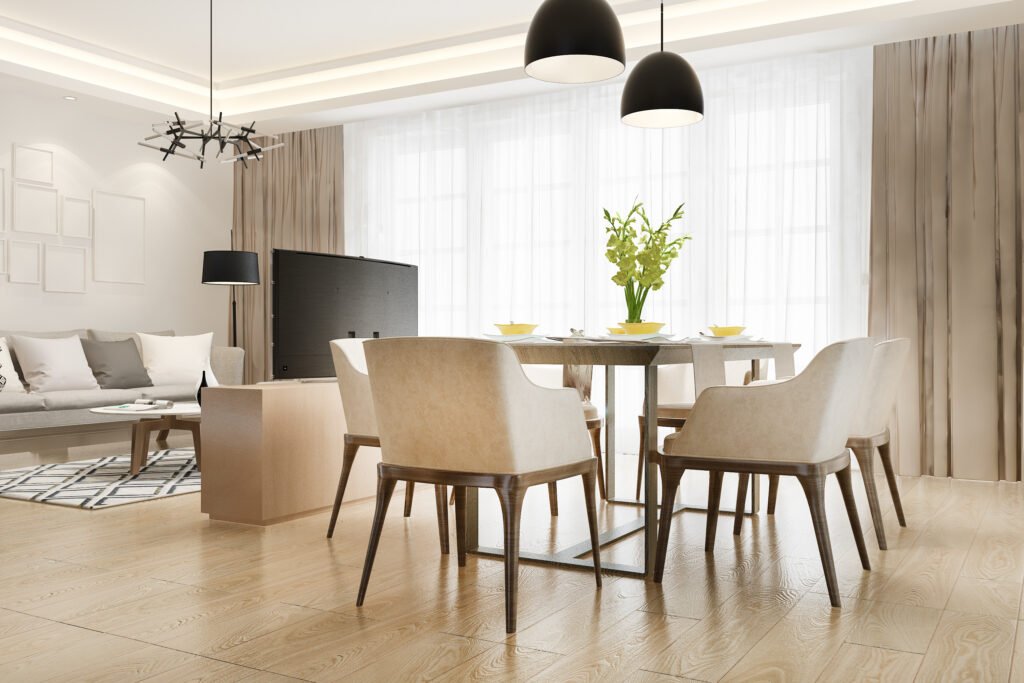Dining Room Light Fixtures: A Comprehensive Guide to Illuminate Your Space
Regarding home décor, lighting plays a pivotal role in setting the ambiance. Dining room light fixtures illuminate the space and define its style. Whether hosting a dinner party or enjoying a family meal, the right light fixture can enhance the dining experience. This article will dive into various types of dining room light fixtures, discuss choosing the best one for your space, and provide recommendations for matching different dining room styles.
Why Dining Room Light Fixtures Matter
Dining room light fixtures are more than just a source of illumination—they are a vital component of your room’s décor. A well-chosen fixture can tie together the room’s design elements, provide functional lighting, and create a focal point that guests will admire.
Dining room lighting has evolved over the years, from chandeliers to pendant lights. Homeowners now have access to a wide range of designs, materials, and styles that fit their preferences, whether they want a contemporary, rustic, or traditional look.
Types of Dining Room Light Fixtures
The market offers a plethora of light fixtures suited for dining rooms. Each fixture serves a different purpose and adds a unique aesthetic. Below are some of the most popular types of dining room lighting solutions.
- Chandeliers
Chandeliers are one of the most common choices for dining rooms. They add elegance and luxury while offering sufficient light coverage for large tables. Modern chandeliers have evolved from the heavy, ornate designs of the past into sleeker, more minimalistic options that can fit various styles, from contemporary to traditional.
Best for: Large dining rooms, formal settings, and high ceilings.
- Pendant Lights
Pendant lights are perfect for those who prefer a modern, minimalistic look. These fixtures are typically hung in a series or cluster over the dining table, providing focused lighting. Pendant lights come in various shapes, materials, and sizes, making them versatile and customizable for different dining spaces.
Best for: Modern and industrial dining rooms, smaller spaces, and casual settings.
- Flush Mount Lights
Flush-mount lights are attached directly to the ceiling without hanging down. They offer a clean, unobtrusive look and are ideal for rooms with low ceilings. These fixtures may not be as dramatic as chandeliers or pendant lights, but they still provide ample lighting for intimate dining areas.
Best for: Small dining rooms or rooms with low ceilings.
- Linear Suspension Lights
Linear suspension lights are a stylish and practical choice for long dining tables. They are typically suspended by rods or cables, extending horizontally over the table to offer even light distribution. Their sleek designs work especially well in modern or minimalist dining rooms.
Best for: Long tables, modern spaces, and open-concept dining areas.
- Recessed Lighting
Recessed lighting, often installed in the ceiling, provides a hidden light source. While not necessarily a focal point like a chandelier or pendant, recessed lighting can offer ambient lighting that enhances the room’s overall mood. aIt’s often combined with other light fixtures to balance light levels.
Best for: Supplemental lighting, minimalist and contemporary dining rooms.
How to Choose the Perfect Dining Room Light Fixture
Selecting the right dining room light fixture requires considering various factors, such as the size of your room, the shape and size of your table, ceiling height, and the style of your home. Here’s a breakdown of key considerations:
- Scale and Proportion
Your light fixture should be proportional to your dining room and table size. A chandelier that is too large or small can throw off the room’s balance. Generally, the width of your chandelier or light fixture should be about 1/2 to 2/3 the width of the dining table.
- Ceiling Height
The height of your ceiling will determine how low or high the fixture should hang. For dining rooms with standard 8-foot ceilings, a chandelier or pendant should hang about 30-34 inches above the table. For higher ceilings, add 3 inches for every additional foot.
- Lighting Style and Functionality
Consider the mood and ambiance you want to create. A formal dining room may benefit from a luxurious chandelier, while a casual, modern space may work better with industrial-style pendant lights. If you need a fixture for task lighting, ensure it provides adequate brightness.
- Energy Efficiency
LED lights are more energy-efficient and have a longer lifespan than traditional incandescent bulbs. Choosing fixtures that support LED bulbs can help save on energy costs while still offering stylish lighting options.
Popular Dining Room Lighting Styles
The style of your light fixture should complement the overall design of your dining room. Below are some popular dining room lighting styles to consider.
- Modern and Minimalist
For modern dining rooms, sleek lines and minimalistic designs are ideal. Pendant lights with clean, geometric shapes in materials like metal or glass can enhance a contemporary space without overwhelming it.
- Rustic and Farmhouse
For a rustic or farmhouse look, fixtures made from wood, wrought iron, or distressed metals will add a cozy, charming vibe. Wooden chandeliers or iron lanterns are lavish for creating a warm and inviting atmosphere.
- Industrial
Industrial-style light fixtures often feature exposed bulbs, metals, and rugged materials like iron or copper. These fixtures work best in loft-style or urban dining spaces and pair well with concrete or brick walls.
- Traditional and Classic
For those with traditional dining room designs, chandeliers with ornate details, crystal elements, or antique finishes can enhance the classic look. These fixtures add a touch of elegance and grandeur to formal dining spaces.
Dining Room Light Fixtures and Smart Home Integration
In recent years, bright lighting has become increasingly popular. With bright dining room light fixtures, you can control the brightness, color temperature, and even the color of the lights using a smartphone app or voice command. Intelligent lighting systems allow you to set the mood for different occasions, whether a bright light for a family dinner or dim lighting for a romantic evening.
Additionally, intelligent fixtures can integrate with home automation systems like Amazon Alexa or Google Home, giving you complete control over your dining room lighting with a simple voice command.
Final Thoughts
Choosing the right dining room light fixtures is crucial to creating a functional and beautiful space. Whether you’re drawn to the elegance of a chandelier, the sleekness of pendant lights, or the practicality of recessed lighting, the perfect fixture can transform your dining room into a welcoming environment.
When choosing the ideal light fixture, consider factors like the size of your room, ceiling height, and your personal style. Remember, light fixtures not only illuminate your space but also serve as an integral part of your dining room’s design aesthetic.
Questions & Answers
Q: How high should a dining room light fixture be hung?
A: For standard 8-foot ceilings, the bottom of the light fixture should hang 30 to 34 inches above the dining table. For taller ceilings, add 3 inches for each extra foot.
Q: What light fixture works best for a small dining room?
A: Flush-mount or compact pendant lights are ideal for smaller dining rooms. These fixtures provide sufficient lighting without overwhelming the space.
Q: Can I use dimmable lights in my dining room?
A: Yes, dimmable lights are an excellent option for dining rooms as they allow you to adjust the brightness depending on the occasion. Whether hosting a formal dinner or having a relaxed family meal, dimmable lights offer flexibility.
Q: What is the best light color for a dining room?
A: Warm white (2700K to 3000K) is often recommended for dining rooms as it creates a cozy and inviting atmosphere.


